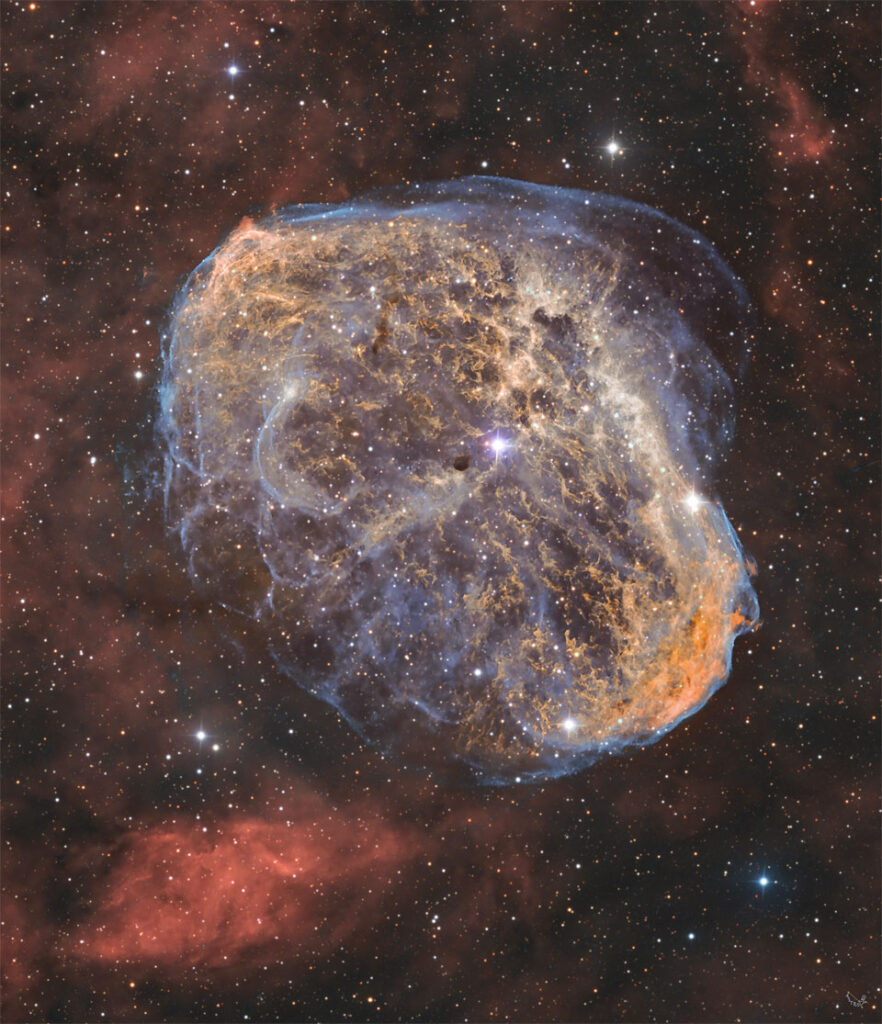
Location of the Crescent Nebula
The Crescent Nebula is located in the constellation of Cygnus (the Swan), at approximately 4,700 light-years away from Earth.
Its celestial coordinates are:
- Right Ascension: 20h 12m
- Declination: +38° 21′
Structure
Origin of the Crescent Nebula
The Crescent Nebula is a result of the interaction between the intense, fast stellar wind from its central Wolf-Rayet star (WR 136) and the slower, earlier stellar wind from the same star’s red supergiant phase.
Wolf-Rayet Star (WR 136)
This massive star is nearing the end of its life and emits intense radiation and stellar winds at speeds of up to 1,700 kilometers per second.
Formation Timeline
The nebula was likely created around 250,000 years ago when WR 136 began shedding material during its red supergiant phase, and as WR 136 evolved, its powerful, newer stellar wind began to collide with the older, slower-moving wind, creating shockwaves and ionizing the surrounding gas.
Bubble-like Shape
The collision of winds creates a shell of gas with a distinct crescent or bubble-like shape, featuring two primary shock fronts—one inner and one outer. This “bubble” structure is dense with glowing hydrogen, oxygen, and sulfur gas, which gives the nebula its color and shape.
Filamentary Detail
The nebula’s edges are defined by intricate filamentary structures resulting from these shockwaves, giving it a distinctive textured appearance that’s highly photogenic and unique among emission nebulae.
Importance
Wolf-Rayet Stars
The Crescent Nebula is valuable for studying the life cycle of Wolf-Rayet stars. These massive, hot stars undergo rapid mass loss as they approach the end of their lives, often culminating in supernovae. Observing WR 136 offers insight into the behavior and ultimate fates of massive stars.
Stellar Wind Interactions
The nebula showcases complex interactions between fast and slow stellar winds, providing clues about mass loss and energy exchange processes in massive stars.
Supernova Precursors
WR 136 is expected to end its life in a supernova. Studying its behavior in the Wolf-Rayet phase offers crucial data on the conditions that lead to such stellar explosions.
Cosmic Recycling
The materials in the Crescent Nebula will eventually disperse into the interstellar medium, enriching it with heavy elements that contribute to future star and planet formation.
Visual Impact
The Crescent Nebula’s vibrant colors—red from hydrogen-alpha, blue-green from oxygen (OIII), and sulfur traces—make it visually striking. The nebula stands out against Cygnus’s star fields, with long-exposure photos revealing its deep textures and glowing filaments.
High Contrast
This nebula contrasts beautifully with the star-rich fields of Cygnus, especially in astrophotography, where images reveal the nebula’s intricate details and structure.
Popular Imaging Target
Its radiant color and complex structure make the Crescent Nebula a popular subject for astrophotographers, who often use narrowband filters like H-alpha and OIII to capture its detail.
Viewing Difficulty
For amateur astronomers, the Crescent Nebula can be challenging to observe visually due to its dimness and fine structure. An OIII filter, however, can enhance contrast, offering a better view of its delicate shape.
Credit
This image has been taken by Team A.R.O. You can learn more about them here.
